|
Size: 856
Comment:
|
Size: 10972
Comment:
|
| Deletions are marked like this. | Additions are marked like this. |
| Line 3: | Line 3: |
| === PreparationRun Sun 12/05 === Left Grenoble by car in the morning, stopped at Calp |
[[PrepRun6|Go to preparation run daily reports]] |
| Line 6: | Line 5: |
| === PreparationRun Mon 13/05 === Arrived at the telescope around 3:30pm. Unloaded the car, installed archeops8, archeops9 and THz in the control room. Updated with SVN. Experiment file for next NIKA run: nika_iram2.txt |
Preparation visit before Run6 |
| Line 9: | Line 7: |
| A few mbars of something in the cryostat (J1=50mbar). | |
| Line 11: | Line 8: |
| === PreparationRun Tue 14/05 === GISMO electronics is still there. Thus first we'll have to wait that it's craned down before starting working on the cryostat. We re-pump the cryostat and the big pumping pipe before the intervention. Jpi is growing up a bit after pumping; 1e-3mbar per minute roughly. Not very dangerous, could be outgassing, but I have seen better. Could be a small leak at the O-rings. In any case we have to open later. |
<<TableOfContents(3)>> === Daily Reports === === Mon 03/06 === Left Grenoble by car in the morning. Andrea, Alain, Alessandro. Reached the telescope at 20h30. === Tue 04/06 === During the maintenance craned up again NIKA, installed. '''Warm impedance test: 20mbar/min at 3 bar''' Start cooling down at 13h30. Test with VNA at 300K: {{attachment:VNA_1mm.jpg||width=600}} {{attachment:VNA_2mm.jpg||width=600}} ''Figures: VNA scans at 300K (0-8GHz). Left: 1mm array; right: 2mm array. Vertical scale 20dB/div.'' Installed the electronics with the cables. {{attachment:nika_back_1.jpg||width=600}} {{attachment:NIKA_back_2.jpg||width=600}} ''Figures: NIKA installed again.'' We have also visited the back of the antenna and in particular the receivers cabin roof for possible installation of the NIKA-2 electronics. Space available is 80cm (H) x 200cm (Width) x 100cm (Depth). In order to have enough space to work, we will use a maximum depth of 60cm. The total COAX cables length if this solution is chosen is 6-8m. {{attachment:roof2.jpg||width=600}} ''Figures: Cabin top, possible place for NIKA-2 electronics.'' '''Cryostat temperatures at 18h (T0 + 4h30). 4K: 255K (14K/h slope); Still: 235K (25K/h slope); R_BM: 1011 Ohm.''' The 4K is slower compared to the last Grenoble runs. We have checked the PT compressor pressures and they're OK: high=28.5bar; low=10bar. So we haven't lost helium. At 18h20 we reduce a bit the preref flux (from 1000mbar to 900mbar) to see if the 4K was affected (it shouldn't in principle). Actually YES, the 4K accelerated and the still slowed down a bit. '''Cryostat temperatures at 20h30 (T0 + 7h). 4K: 207K (20K/h slope); Still: 165K (27K/h slope); R_BM: 1020 Ohm.''' '''Cryostat temperatures at 22h30 (T0 + 9h). 4K: 164K (20K/h slope); Still: 115K (22K/h slope); R_BM: 1026 Ohm.''' === Wed 05/06 === Cooling a bit slower than last time in Grenoble but still comparable. Hopes for condensation start in the morning. Pressures in the PT compressor: 27bar (high); 10bar (low). '''Cryostat temperatures at 9h30 (T0 + 20h). 4K: 6.5K (0.4K/h slope); Still: 9.2K (4K/h slope); R_BM: 1190 Ohm (10.3K).''' '''Cryostat temperatures at 10h30 (T0 + 21h). 4K: 5.7K; Still: 7.1K; R_BM: 1220 Ohm (8.9K).''' '''11h (T0+21.5h) START CONDENSATION.''' '''12h15. Condensation started OK, mixing chamber cooling fast, Switching ON the cold amplifiers to check arrays connections. Waiting for the superconducting T.''' '''12h45. Both arrays seem CONNECTED. The Tc is between 1.35 and 1.5K (but mixing chamber thermometer calibration is not perfect) and as expected the transition is seen on the 2mm array first.''' '''16h30. RESONANCES !!! 198 at 1mm, 129 at 2mm. Cryostat reached 120mK at least but oscillating and now heating up around 200mK again. Noise (very preliminary) seems OK on both arrays: 1Hz/sqrt(Hz) on the 2mm, 3Hz/sqrt(Hz) on, the 1mm. Ongoing.. ''' 18h00. The first test we made is to turn the antenna by 180deg in AZ (EL was roughly 45deg) to check if the resonances are stable with B fields or not. They seem stable enough, but very small (around 20Hz only) jumps are in any case seen on some pixels of the 2mm array during the slew. {{attachment:saut1.jpg||width=700}} {{attachment:saut2.jpg||width=700}} ''Figures: Small jumps on one pixel (2mm array) during 180deg slew in AZ. The drift in the time trace is due to temperature drift of the mixing chamber during the test.'' Nicolas, working remotely from Grenoble, analyzed the timelines during the slew and found 3-4 detectors exhibiting larger jumps (see next figure), of about 1kHz. {{attachment:saut78.jpg||width=700}} ''Figure: Bigger jumps on a particular pixel (1mm array, numdet=78) during 180deg slew in AZ (NP).'' === Thu 06/06 === 1h00. Added roughly 30mbar of 3He in the reserve. 08h30. The cryostat spent in any case the night oscillating. {{attachment:BM1.jpg||width=700}} ''Figure: Mixing chamber of the cryostat oscillating.'' '''The heater on the mixing chamber, allowing to regulate the temperature, is broken inside the cryostat ! So no regulation possible unfortunately.''' That's a bit annoying since we are also quite warm with the cryostat in this shape. The white noise on the arrays seems good, but there are lines at 0.96Hz (both arrays), 1.9Hz (1mm) and higher (mostly 1mm array). Y9_10h11 (2mA chauffage, oscillations 204-216mK periode 150s, J4=980mbar) Y9_10h38 (2.3mA chauffage, oscillations 208-215mK periode 150s, J4=1020mbar) Y9_10h58 (2.6mA chauffage, oscillations 0.1-1mK periode 150s, J4=1530mbar) In this last conditions it seems more or less stable, but at 220mK. J4 is not too high. The detectors are working (the 1mm a bit limited), so we decide to leave it alone. Parameter files: run6_window.txt AND run_6_300K.txt (on archeops9 and archeops10). The 2mm array has been adjusted, the 1mm not yet. '''On the 2mm array, from window closed to 300K (window open, looking at the cabin), the frequency shift is 100kHz. In Grenoble this array exhibited a shift of about 180kHz between 80K and 300K, equivalent to 0.8kHz/K. So, it seems that the windows is only equivalent to 300-100/0.8=175K. LN2 in front of the window determines a shift of 60kHz on the 2mm array (means the LN2 is colder than the window by 60KHz on average). Assuming the Grenoble calibration of 0.8KHz/K it means a Delta_T of 75K. So from this we would conclude that the window is 77+75=152K. Not too far from the 175K estimated starting from the 300K. SO THE WINDOW IS EQUIVALENT TO 160+/-10K !!! ''' '''On the 1mm array, from window closed to 300K (window open, looking at the cabin), the frequency shift is 150kHz. Remember we have one additional filter 9cm-1 this time. This might reduce a bit the sensitivity. LN2 in front of the window determines a shift of 110kHz on the 1mm array''' === ..... Mon-Tue 10-11/06 'TO DO LIST' FOR MARTINO (sorry, in italian) === - Scan VNA sulle matrici (finestra chiusa e finestra aperta) con il PC del VNA. - Verificare i params e, soprattutto per la 1mm, aggiustare i livelli di potenza. Sulla 2mm dovrebbero essere già giusti più o meno, ma per favore ricontrolla se hai tempo. I params, che trovi su archeops9 (nella directory .../Data/param), si chiamano "run6_window.txt" e "run6_300K.txt". Per la 1mm i livelli sono tutti da fare. - allineamento (con Santiago e Nello martedi' mattina). Attenzione, i piedini regolabili sono molto più alti dell'ultima volta. La tavola anti-vibrazione è già in funzione. Al piano dove c'e' l'elettronica di GISMO abbiamo trovato una tavola inutilzzata con 4 piedini di quel tipo. Se per caso uno dei nostri si dovesse rompere, chiedete di smontarne uno di quelli. - PRENDERE TEMPO (tutto il tempo che serve !) PRIMA DI OSSERVARE SORGENTI ETC. PER RIFARE UN BUON PARAM SUL CIELO. Da fare martedi' alla first light. Quindi dite che avete bisogno di 1-2 ore per fare quello prima di mettersi a fare OTF_geometry etc. - controllare sempre il criostato. J4 non deve esplodere (diciamo rimanere stabile attorno a 1.5bar o un po' più, ma non andare verso i 3 bar. Il tutto è in equilibrio instabile - ho l'impressione che non si debbano schtchare i cavi semirigidi sulle barre del criostato. Ho messo degli "attenuatori di vibrazione" al posto. Mi sembra che questo riduca le righe di rumore almeno sulla 2mm. Ma magari è un mito. - tutte le nostre cose, da riportare a Grenoble, sono al piano appena sotto la cabina e in un angolo al piano del compressore. Un po' oltre la "trap", contro il muro sulla destra. .... altre cose che vi verranno in mente. === Fri 07/06 === 10h30 Alain and Alessandro left the telescope. 11h00 Add parameter file: run6_77K.txt (on archeops9) levels adjusted on 1mm and 2mm channels After an instability of the cryostat during the last night, temperature fluctuations of the Still are increasing. This can be observed on the pirani gauge (see figure-07/06-1). The impact on data is still not dramatic as shown in figures-07/06-2 (hoping don't get worse). {{attachment:pirani.jpg||width=700}} ''Figure-07/06-1: Pirani gauge'' {{attachment:c1mm.jpg||width=700}} {{attachment:c2mm.jpg||width=700}} ''Figure-07/06-2: Impact of 100mk plate temperature fluctuations on 1mm and 2mm channel.'' === Sat 08/06 === Fluctuations of the plate temperature are smaller then yesterday. The first component of about 1mk peak to peak has a period of about 1.5 hours (Fig08/06-1 left). The second component of about 0.1mK has a period of 1.4min (Fig08/06-1 right). Both of these plate fluctuations have a very small impact on data and they should not add any additional noise on scientific data. (see figure 08/06-2). The white noise on pixels is presented in figure 08/06-3. The lines are still present {{attachment:BM.jpg||width=700}} {{attachment:BM_1.jpg||width=700}} ''Figure-08/06-1: The two components of the mixer chamber temperature fluctuations.'' {{attachment:signal1.jpg||width=700}} {{attachment:signal2.jpg||width=700}} ''Figure-08/06-2: RFdIdQ (about 80min) for 1mm and 2mm channels'' {{attachment:noise1.jpg||width=700}} {{attachment:noise2.jpg||width=700}} ''Figure-08/06-3: Noise spectrum for 1mm and 2mm'' '''19h56 : Opacity 1.5!!! Be of good auspice for the next week.....''' === Sun 09/06 === Fluctuations of the plate temperature are getting worse. The mixing chamber temperature has a fluctuation of 1.5mK with a period of about 1.5min (see Fig09/06-1). This has as impact on the signal as shown in Fig09/06-2. The plan is to recycle the cryostat on Monday morning. This should (hopefully) stabilize the working temperature for the whole campaign. {{attachment:BM_2.jpg||width=700}} ''Figure-09/06-1: The mixer chamber temperature fluctuations.'' {{attachment:signal_11.jpg||width=700}} {{attachment:signal_12.jpg||width=700}} ''Figure-09/06-2: RFdIdQ for 1mm and 2mm channels'' === Tue 11/06 === FXD, RA, AD, MC, SL, NB at the telescope Dilution fridge recycled yesterday (warm enough to turn He to gas, pump, cool down again). Base temperature stabilized around 216 mK naturally (with setting of 3He circulation, trying to mitigate strongly the fluctuations due to the small leak). Laser alignment before lunch (+ tight screws of NIKA table leg & micrometric screws fixation on M5). Check pako scripts during the maintenance. Obs plan: check resonance, pointing & focus, 1st skydip, 1st far field geometry, pointing session, implement pointing model, calibration sequences iterations. {{attachment:res_skydip_up_20130611-159.jpg}} {{attachment:skydip_up_20130611-159.jpg}} ''Figure-11/06-1: First Sky Dip reduction data (scan 159)'' |
Go to preparation run daily reports
Preparation visit before Run6
Contents
Daily Reports
Mon 03/06
Left Grenoble by car in the morning. Andrea, Alain, Alessandro. Reached the telescope at 20h30.
Tue 04/06
During the maintenance craned up again NIKA, installed. Warm impedance test: 20mbar/min at 3 bar
Start cooling down at 13h30.
Test with VNA at 300K:
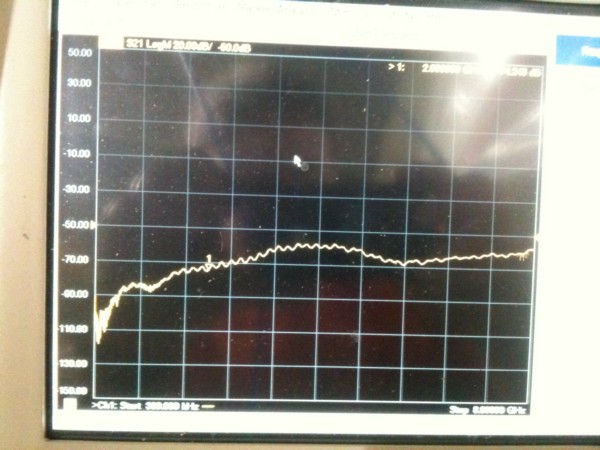
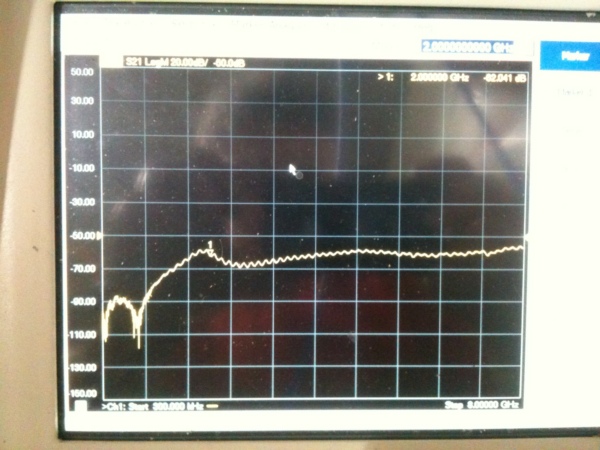
Figures: VNA scans at 300K (0-8GHz). Left: 1mm array; right: 2mm array. Vertical scale 20dB/div.
Installed the electronics with the cables.
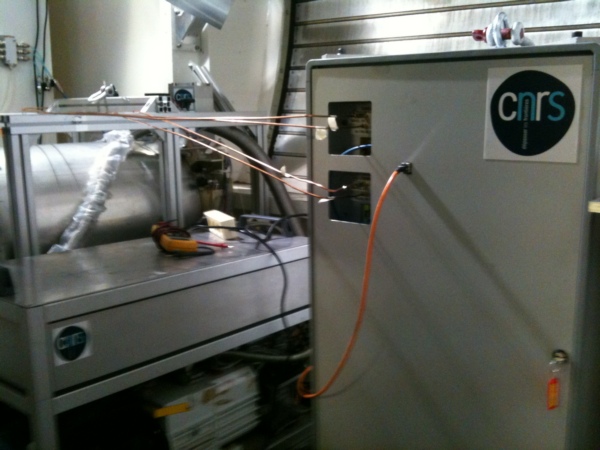
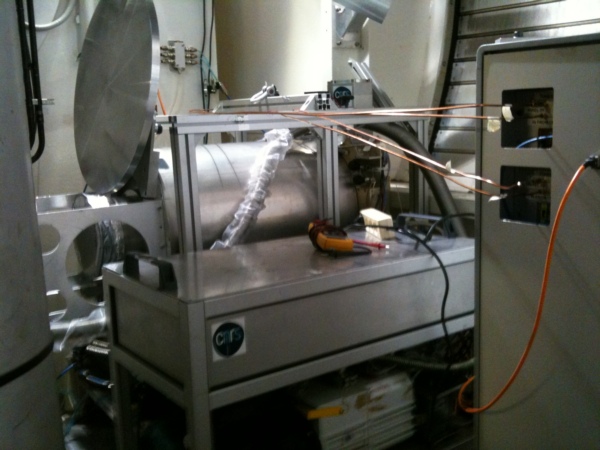
Figures: NIKA installed again.
We have also visited the back of the antenna and in particular the receivers cabin roof for possible installation of the NIKA-2 electronics. Space available is 80cm (H) x 200cm (Width) x 100cm (Depth). In order to have enough space to work, we will use a maximum depth of 60cm. The total COAX cables length if this solution is chosen is 6-8m.

Figures: Cabin top, possible place for NIKA-2 electronics.
Cryostat temperatures at 18h (T0 + 4h30). 4K: 255K (14K/h slope); Still: 235K (25K/h slope); R_BM: 1011 Ohm.
The 4K is slower compared to the last Grenoble runs. We have checked the PT compressor pressures and they're OK: high=28.5bar; low=10bar. So we haven't lost helium. At 18h20 we reduce a bit the preref flux (from 1000mbar to 900mbar) to see if the 4K was affected (it shouldn't in principle). Actually YES, the 4K accelerated and the still slowed down a bit.
Cryostat temperatures at 20h30 (T0 + 7h). 4K: 207K (20K/h slope); Still: 165K (27K/h slope); R_BM: 1020 Ohm.
Cryostat temperatures at 22h30 (T0 + 9h). 4K: 164K (20K/h slope); Still: 115K (22K/h slope); R_BM: 1026 Ohm.
Wed 05/06
Cooling a bit slower than last time in Grenoble but still comparable. Hopes for condensation start in the morning. Pressures in the PT compressor: 27bar (high); 10bar (low).
Cryostat temperatures at 9h30 (T0 + 20h). 4K: 6.5K (0.4K/h slope); Still: 9.2K (4K/h slope); R_BM: 1190 Ohm (10.3K).
Cryostat temperatures at 10h30 (T0 + 21h). 4K: 5.7K; Still: 7.1K; R_BM: 1220 Ohm (8.9K).
11h (T0+21.5h) START CONDENSATION.
12h15. Condensation started OK, mixing chamber cooling fast, Switching ON the cold amplifiers to check arrays connections. Waiting for the superconducting T.
12h45. Both arrays seem CONNECTED. The Tc is between 1.35 and 1.5K (but mixing chamber thermometer calibration is not perfect) and as expected the transition is seen on the 2mm array first.
16h30. RESONANCES !!! 198 at 1mm, 129 at 2mm. Cryostat reached 120mK at least but oscillating and now heating up around 200mK again. Noise (very preliminary) seems OK on both arrays: 1Hz/sqrt(Hz) on the 2mm, 3Hz/sqrt(Hz) on, the 1mm. Ongoing..
18h00. The first test we made is to turn the antenna by 180deg in AZ (EL was roughly 45deg) to check if the resonances are stable with B fields or not. They seem stable enough, but very small (around 20Hz only) jumps are in any case seen on some pixels of the 2mm array during the slew.
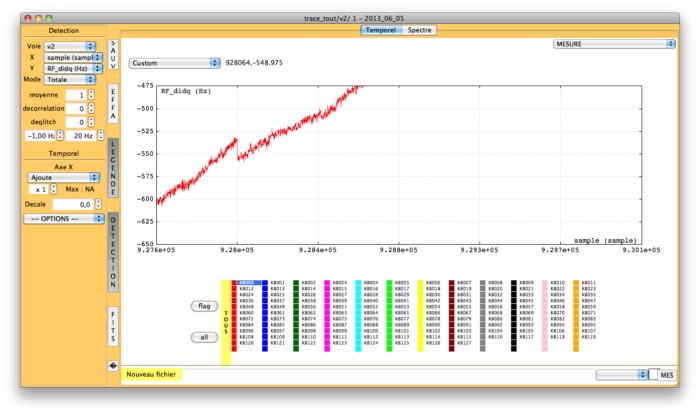
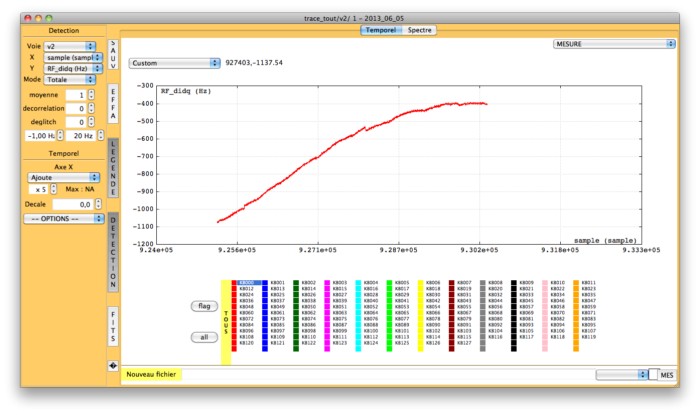
Figures: Small jumps on one pixel (2mm array) during 180deg slew in AZ. The drift in the time trace is due to temperature drift of the mixing chamber during the test.
Nicolas, working remotely from Grenoble, analyzed the timelines during the slew and found 3-4 detectors exhibiting larger jumps (see next figure), of about 1kHz.
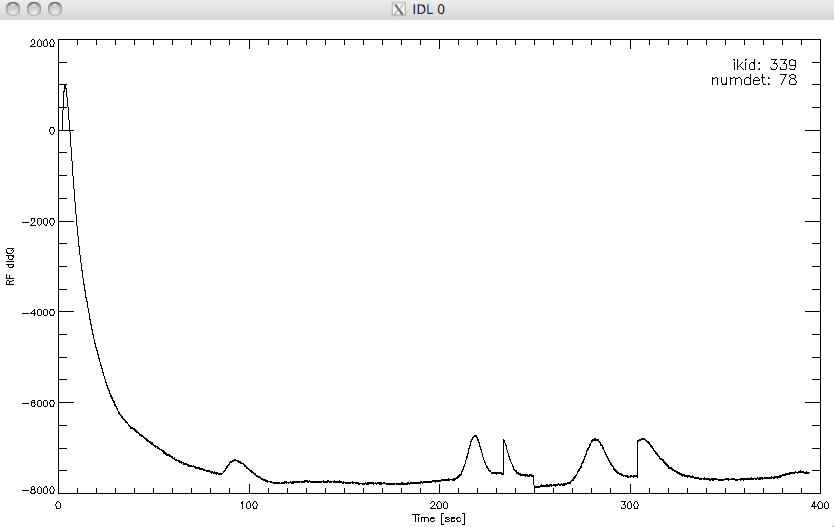
Figure: Bigger jumps on a particular pixel (1mm array, numdet=78) during 180deg slew in AZ (NP).
Thu 06/06
1h00. Added roughly 30mbar of 3He in the reserve.
08h30. The cryostat spent in any case the night oscillating.
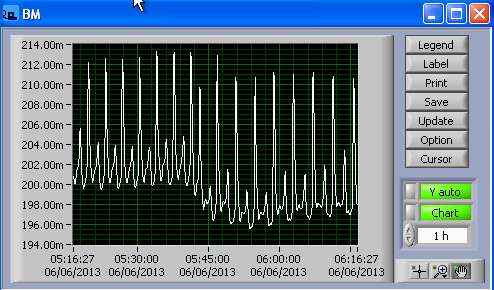
Figure: Mixing chamber of the cryostat oscillating.
The heater on the mixing chamber, allowing to regulate the temperature, is broken inside the cryostat ! So no regulation possible unfortunately. That's a bit annoying since we are also quite warm with the cryostat in this shape.
The white noise on the arrays seems good, but there are lines at 0.96Hz (both arrays), 1.9Hz (1mm) and higher (mostly 1mm array).
Y9_10h11 (2mA chauffage, oscillations 204-216mK periode 150s, J4=980mbar)
Y9_10h38 (2.3mA chauffage, oscillations 208-215mK periode 150s, J4=1020mbar)
Y9_10h58 (2.6mA chauffage, oscillations 0.1-1mK periode 150s, J4=1530mbar)
In this last conditions it seems more or less stable, but at 220mK. J4 is not too high. The detectors are working (the 1mm a bit limited), so we decide to leave it alone.
Parameter files: run6_window.txt AND run_6_300K.txt (on archeops9 and archeops10).
The 2mm array has been adjusted, the 1mm not yet.
On the 2mm array, from window closed to 300K (window open, looking at the cabin), the frequency shift is 100kHz. In Grenoble this array exhibited a shift of about 180kHz between 80K and 300K, equivalent to 0.8kHz/K. So, it seems that the windows is only equivalent to 300-100/0.8=175K. LN2 in front of the window determines a shift of 60kHz on the 2mm array (means the LN2 is colder than the window by 60KHz on average). Assuming the Grenoble calibration of 0.8KHz/K it means a Delta_T of 75K. So from this we would conclude that the window is 77+75=152K. Not too far from the 175K estimated starting from the 300K. SO THE WINDOW IS EQUIVALENT TO 160+/-10K !!!
On the 1mm array, from window closed to 300K (window open, looking at the cabin), the frequency shift is 150kHz. Remember we have one additional filter 9cm-1 this time. This might reduce a bit the sensitivity. LN2 in front of the window determines a shift of 110kHz on the 1mm array
..... Mon-Tue 10-11/06 'TO DO LIST' FOR MARTINO (sorry, in italian)
- Scan VNA sulle matrici (finestra chiusa e finestra aperta) con il PC del VNA.
- Verificare i params e, soprattutto per la 1mm, aggiustare i livelli di potenza. Sulla 2mm dovrebbero essere già giusti più o meno, ma per favore ricontrolla se hai tempo. I params, che trovi su archeops9 (nella directory .../Data/param), si chiamano "run6_window.txt" e "run6_300K.txt". Per la 1mm i livelli sono tutti da fare.
- allineamento (con Santiago e Nello martedi' mattina). Attenzione, i piedini regolabili sono molto più alti dell'ultima volta. La tavola anti-vibrazione è già in funzione. Al piano dove c'e' l'elettronica di GISMO abbiamo trovato una tavola inutilzzata con 4 piedini di quel tipo. Se per caso uno dei nostri si dovesse rompere, chiedete di smontarne uno di quelli.
- PRENDERE TEMPO (tutto il tempo che serve !) PRIMA DI OSSERVARE SORGENTI ETC. PER RIFARE UN BUON PARAM SUL CIELO. Da fare martedi' alla first light. Quindi dite che avete bisogno di 1-2 ore per fare quello prima di mettersi a fare OTF_geometry etc.
- controllare sempre il criostato. J4 non deve esplodere (diciamo rimanere stabile attorno a 1.5bar o un po' più, ma non andare verso i 3 bar. Il tutto è in equilibrio instabile
- ho l'impressione che non si debbano schtchare i cavi semirigidi sulle barre del criostato. Ho messo degli "attenuatori di vibrazione" al posto. Mi sembra che questo riduca le righe di rumore almeno sulla 2mm. Ma magari è un mito.
- tutte le nostre cose, da riportare a Grenoble, sono al piano appena sotto la cabina e in un angolo al piano del compressore. Un po' oltre la "trap", contro il muro sulla destra.
.... altre cose che vi verranno in mente.
Fri 07/06
10h30 Alain and Alessandro left the telescope.
11h00 Add parameter file: run6_77K.txt (on archeops9) levels adjusted on 1mm and 2mm channels
After an instability of the cryostat during the last night, temperature fluctuations of the Still are increasing. This can be observed on the pirani gauge (see figure-07/06-1). The impact on data is still not dramatic as shown in figures-07/06-2 (hoping don't get worse).
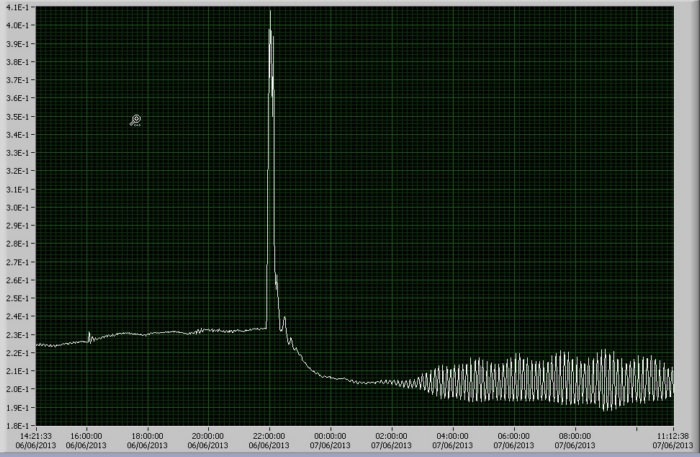
Figure-07/06-1: Pirani gauge
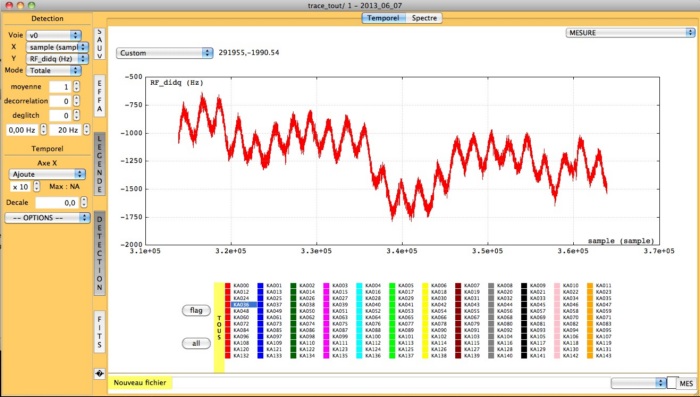
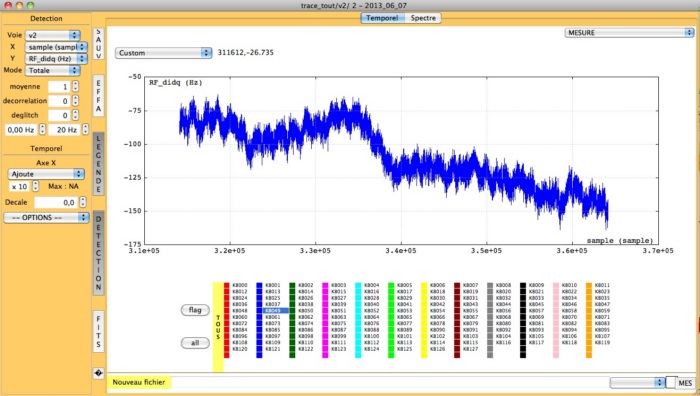
Figure-07/06-2: Impact of 100mk plate temperature fluctuations on 1mm and 2mm channel.
Sat 08/06
Fluctuations of the plate temperature are smaller then yesterday. The first component of about 1mk peak to peak has a period of about 1.5 hours (Fig08/06-1 left). The second component of about 0.1mK has a period of 1.4min (Fig08/06-1 right). Both of these plate fluctuations have a very small impact on data and they should not add any additional noise on scientific data. (see figure 08/06-2). The white noise on pixels is presented in figure 08/06-3. The lines are still present
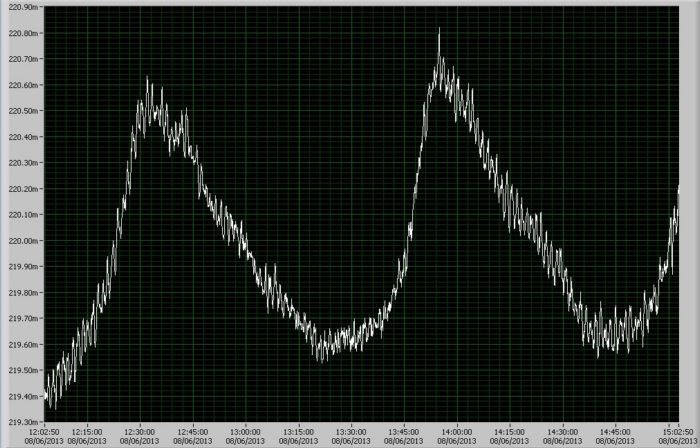
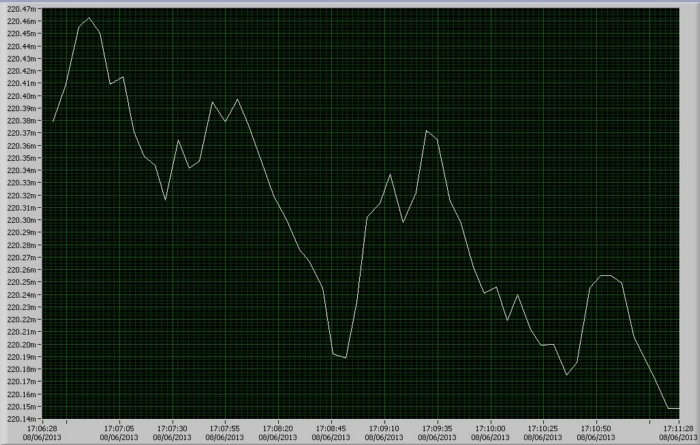
Figure-08/06-1: The two components of the mixer chamber temperature fluctuations.
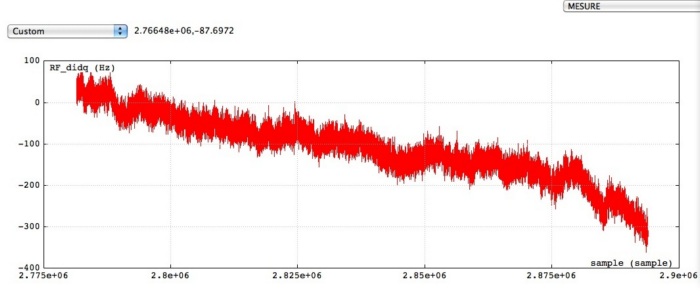
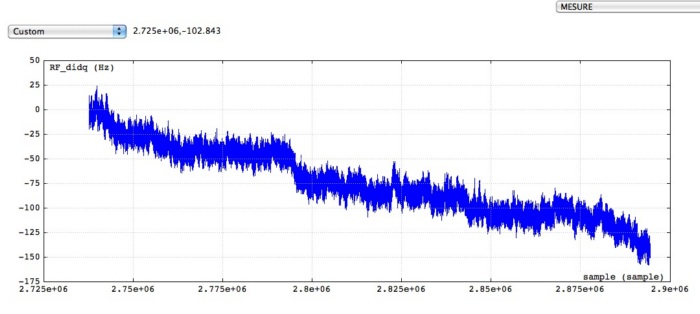
Figure-08/06-2: RFdIdQ (about 80min) for 1mm and 2mm channels
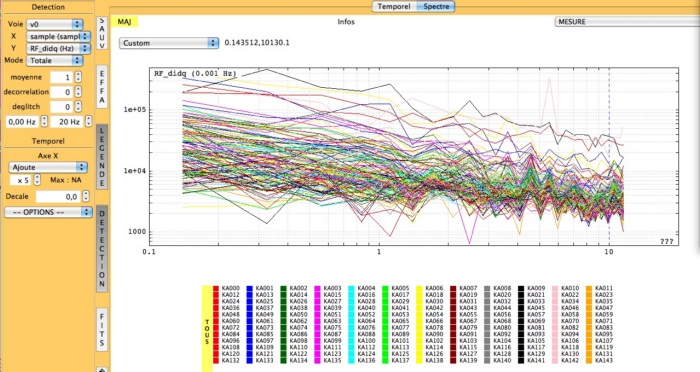
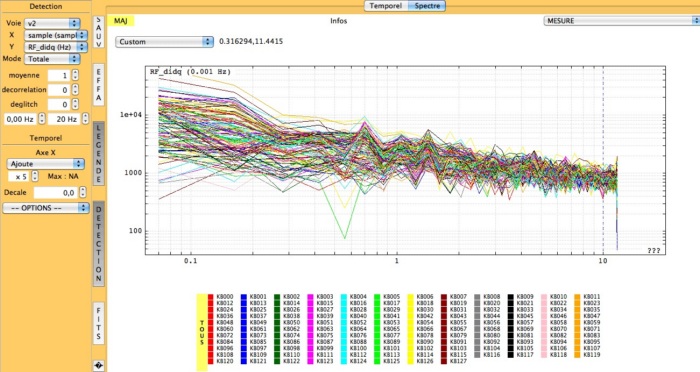
Figure-08/06-3: Noise spectrum for 1mm and 2mm
19h56 : Opacity 1.5!!! Be of good auspice for the next week.....
Sun 09/06
Fluctuations of the plate temperature are getting worse. The mixing chamber temperature has a fluctuation of 1.5mK with a period of about 1.5min (see Fig09/06-1). This has as impact on the signal as shown in Fig09/06-2. The plan is to recycle the cryostat on Monday morning. This should (hopefully) stabilize the working temperature for the whole campaign.
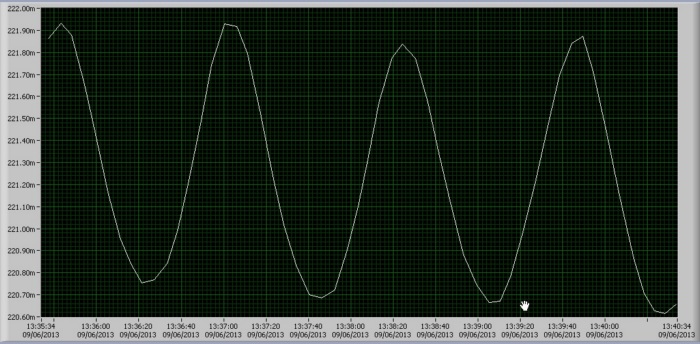
Figure-09/06-1: The mixer chamber temperature fluctuations.
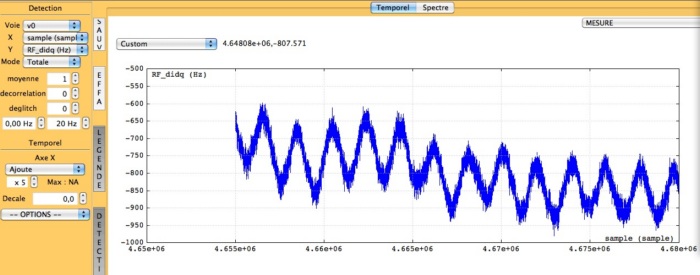
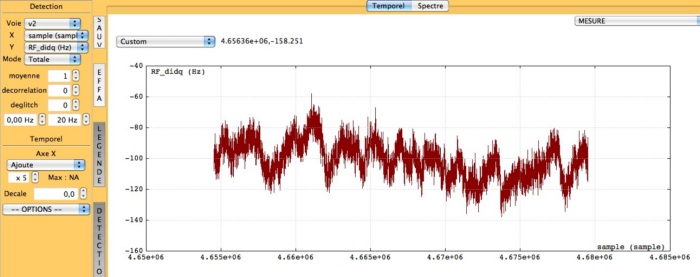
Figure-09/06-2: RFdIdQ for 1mm and 2mm channels
Tue 11/06
FXD, RA, AD, MC, SL, NB at the telescope
Dilution fridge recycled yesterday (warm enough to turn He to gas, pump, cool down again). Base temperature stabilized around 216 mK naturally (with setting of 3He circulation, trying to mitigate strongly the fluctuations due to the small leak).
Laser alignment before lunch (+ tight screws of NIKA table leg & micrometric screws fixation on M5). Check pako scripts during the maintenance.
Obs plan: check resonance, pointing & focus, 1st skydip, 1st far field geometry, pointing session, implement pointing model, calibration sequences iterations.
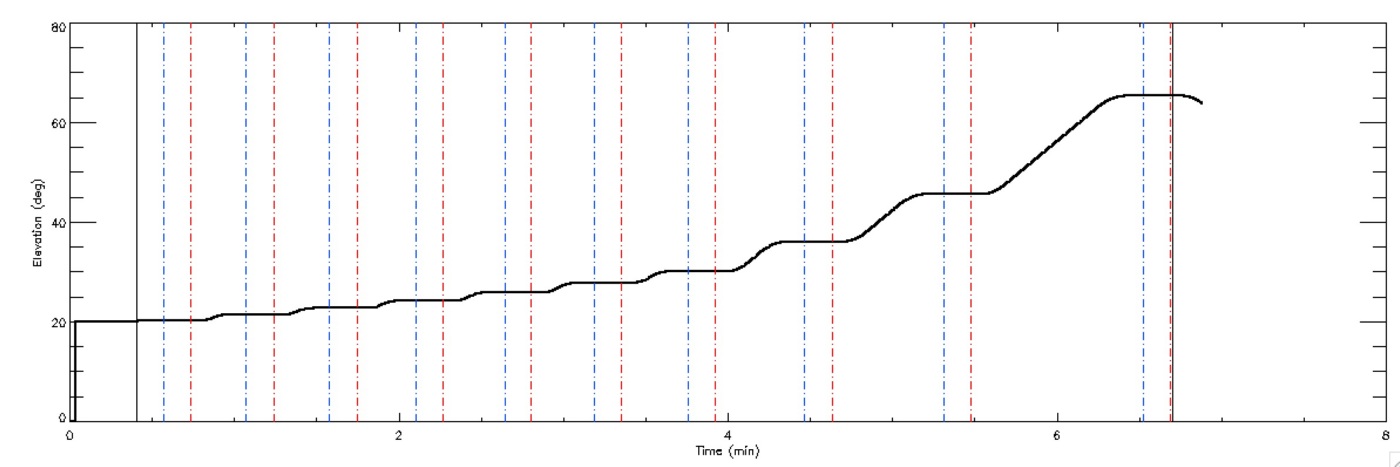

Figure-11/06-1: First Sky Dip reduction data (scan 159)
